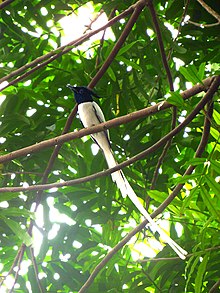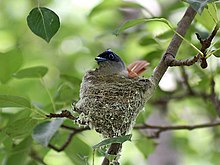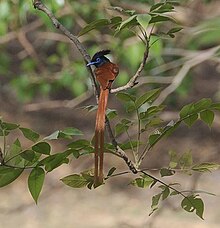Asian paradise flycatcher
| Asian paradise flycatcher | ||||||||||||
|---|---|---|---|---|---|---|---|---|---|---|---|---|

Male Terpsiphone paradisi in Sri Lanka |
||||||||||||
| Systematics | ||||||||||||
|
||||||||||||
| Scientific name | ||||||||||||
| Terpsiphone paradisi | ||||||||||||
| ( Linnaeus , 1758) |
The Asiatic Paradise Flycatcher ( Terpsiphone paradisi ) is a medium-sized passerine bird from the monarch family that is widespread in large parts of Asia . Since the population appears to be stable, the IUCN has classified the species as not endangered since 2004.
In 1758, Carl von Linné was the first to describe the species in the 10th edition of his work Systema Naturae and named it Corvus paradisi .
Appearance
Asian paradise flycatchers are 19–22 cm tall. Its head is glossy black with a hood, its blue beak is round and strong with a black tip. Your iris is dark brown to black. They have short, slender legs and small feet. Their wings are 86–92 mm long.
The sexes are dimorphic in the color of the plumage . Female paradise flycatchers have reddish-brown plumage behind, a light gray throat and a light belly. Male paradise flycatchers change over the course of the first three years of life. As young birds they look very similar to the females, but have a black throat and blue rimmed eyes. In the 2nd year of life they develop tail feathers up to 24 cm long. From the age of 3, their plumage turns white, and the middle two of 12 tail feathers are up to 30 cm long.
In Borneo, and probably also in Sumba , most male juveniles molt directly to white plumage.
distribution and habitat

Asian Paradise Flycatchers inhabit densely forested areas from Turkestan to Manchuria , India , Sri Lanka , in northern and eastern China and in the south to the Malay Archipelago on the islands of Sumba and Alor . They are not sedentary in Korea and the Maldives and regionally extinct in Singapore .
They are migratory birds and spend the cold season in the tropics of Asia. There are resident populations in southern India and Sri Lanka, so that both the visiting migratory birds and the locally breeding subspecies occur there in winter.
Subspecies and their distribution
According to Linnaeus' first description, Asian paradise flycatchers are native to India. Later, naturalists observed them in other parts of Asia and described several subspecies that differ primarily in the plumage of male birds from the nominal subspecies . Today ornithologists recognize the following 14 subspecies:
- Terpsiphone paradisi paradisi (Linnaeus, 1758) breeds in central and southern India, Bangladesh, and southwest Myanmar ; the populations that overwinter in Sri Lanka do not breed there.
- Terpsiphone paradisi leucogaster ( Swainson , 1838) breeds in western Tian Shan , Afghanistan , northern Pakistan , northwest and central India, and Nepal's western and central regions; the populations found in the east of Pakistan and in the south of India do not breed there.
- Terpsiphone paradisi affinis ( Blyth , 1846) lives in Malaysia and Sumatra .
- Terpsiphone paradisi incei ( Gould , 1852) breeds in eastern, northeastern and central China , in the Primorye region in the Far East of Russia and in northern Korea ; the populations found in southeast Asia do not breed there.
- Terpsiphone paradisi insularis ( Salvadori , 1887) lives on the island of Nias, northwest of Sumatra.
- Terpsiphone paradisi nicobarica ( Oates , 1890) lives on the Nicobar Islands .
- Terpsiphone paradisi sumbaensis ( Meyer , 1894) lives on the Small Sunda Island of Sumba .
- Terpsiphone paradisi floris ( Büttikofer , 1894) lives on the Lesser Sunda Islands Sumbawa , Flores , Lomblen and Alor .
- Terpsiphone paradisi procera ( Richmond , 1903) lives on the island of Simeuluë, northwest of Sumatra.
- Terpsiphone paradisi ceylonensis ( Zarudny & Härms, 1912) occurs in Sri Lanka .
- Terpsiphone paradisi borneensis ( Hartert , 1916) lives in Borneo .
- Terpsiphone paradisi saturatior ( Solomon Islands , 1933) breeds in eastern Nepal and northeastern India, eastern Bangladesh and northern Myanmar; the population living in Malaysia does not breed there.
- Terpsiphone paradisi burmae (Solomon Islands , 1933) lives in the central region of Myanmar.
- Terpsiphone paradisi indochinensis (Solomon Islands , 1933) lives in eastern Myanmar, in Yunnan in southern China and moves through Thailand and Indochina to Malaysia , Sumatra and the neighboring islands.
Way of life

Asiatic paradise flycatchers feed on insects and usually hunt their prey in flight at a height of 1–2 m above the ground. They rarely look for insects in the foliage.
In dry weather, they like to bathe and plunge into small water holes or shallow streams several times a day, also to drink. Then they sit down on a branch and clean themselves.
The breeding season for monogamous insect hunters begins in Thailand in early March and lasts until mid-July. The first harbingers of the migrating populations arrive in the Terai of Nepal at the end of March . The male adult birds are the first to be noticed when they tirelessly chase after the mosquitoes with their long white veils , which begin to multiply at this time of the year. The breeding season here begins a little later, around mid-April, and lasts until August.
They soon start looking for a suitable nesting site in the woods and groves. They inspect tall shrubs and low trees that offer enough shade and hiding place to protect their offspring from nest robbers. Once found, they vigorously defend their preferred nesting site against other breeding pairs in the immediate vicinity. They prefer to build their fragile nests 2–3 m high above the ground, well camouflaged and hung between forks of branches.
They need about a week to build their cone-shaped nests from fine roots, moss, dry grass and small leaves, which they hold together with cobwebs and softly cushion the inside with fibers. The females lay 3–4 pale pink eggs - no more than one egg per day - which both parents incubate alternately for about 2 weeks. Once the young have hatched, the parents care for them in the nest for 13-14 days. When they fledge, they buzz tirelessly around the nest and start nagging with loud shouts and singing until the chicks dare to jump out of the nest. They are then fed in the thick bushes for a few more days.
Ornithologists have observed in the Khao Pra-Bang Khram Game Reserve in southern Thailand that older couples - females with long-tailed male paradise flycatchers - start breeding much earlier than young couples - females with short-tailed paradisecatchers. The clutches of older breeding pairs are on average larger, and their chicks somewhat heavier than those of young breeding pairs.
As soon as the monsoon clouds retreat from the Terai of Nepal and India in mid-September , the paradise flycatchers and their young move back south to their winter quarters.
Individual evidence
- ↑ a b Terpsiphone paradisi in the endangered Red List species the IUCN 2011. Posted by: BirdLife International, 2009. Accessed November 14, 2011th
- ^ A b C. Linnæus: Caroli Linnæi Systema naturæ per regna tria naturæ, secundum classes, ordines, genera, species, cum characteribus, differentiis, synonymis, locis. Editio decima, reformata. Impensis Direct. Laurentii Salvii, Holmiæ 1758.
- ↑ a b c T. Mizuta, S. Yamagishi: Breeding biology of monogamous Asian Paradise Flycatcher Terpsiphone paradisi (Aves: Monarchinae): A special reference to color dimorphism and exaggerated long tails in male. In: Raffles Bulletin of Zoology. Volume 46, No. 1, 1998, pp. 101-112. ( rmbr.nus.edu.sg ( Memento from June 6, 2011 in the Internet Archive ), PDF; 18.7 MB).
- ↑ DF Owen: The rufous and white forms of an Asiatic paradise flycatcher, Terpsiphone paradisi. In: Ardea. Volume 51, 1963, pp. 230-236. ( ardeajournal.natuurinfo.nl ( memento of July 24, 2011 in the Internet Archive ), PDF; 300 kB).
- ↑ a b c B. J. Coates, GCL Dutson, CE Filardi: Family Monarchidae (Monarch-Flycatchers). In: J. del Hoyo, A. Elliott, DA Christie (Eds.): Handbook of the Birds of the World. Volume 11: Old World Flycatchers to Old World Warblers. Lynx Editions, Barcelona 2006, ISBN 84-96553-06-X , pp. 244-329.
- ^ RSP Bates: Migration of the Paradise Flycatcher Tchitrea paradisi. In: Journal of the Bombay Natural History Society. Volume 35, No. 4, 1932, pp. 896-897.
- ^ H. Whistler: The migration of the Paradise Flycatcher, (Tchitrea paradisi). In: Journal of the Bombay Natural History Society. Volume 36, No. 2, 1933, pp. 498-499.
- ^ A b c P. C. Rasmussen, JC Anderton: Birds of South Asia: The Ripley Guide. Vol. 2, Smithsonian Institution and Lynx Edicions, 2005, pp. 332-333.
- ^ JL Peters: Check-list of birds of the world. Volume 11, Harvard University Press, 1931.
- ↑ a b c V. Gokula, L. Vijayan: orientalbirdclub.org . In: Forktail. Volume 19, 2003, pp. 142-144.
literature
- C. Robson: A field guide to the birds of South-East Asia. New Holland, London 2000, ISBN 1-85368-313-2 .
- S. Ali, SD Ripley: Handbook of the Birds of India and Pakistan: Together with those of Bangladesh, Nepal, Bhutan and Sri Lanka. Volume 7: Laughing Thrushes to the Mangrove Whistler. Oxford University Press, 1996, ISBN 0-19-563590-6 .
Web links
- The Internet Bird Collection: Asian Paradise-flycatcher (Terpsiphone paradisi)
- Terpsiphone paradisi in the endangered Red List species the IUCN 2011. Posted by: BirdLife International, 2009. Accessed November 14, 2011th


